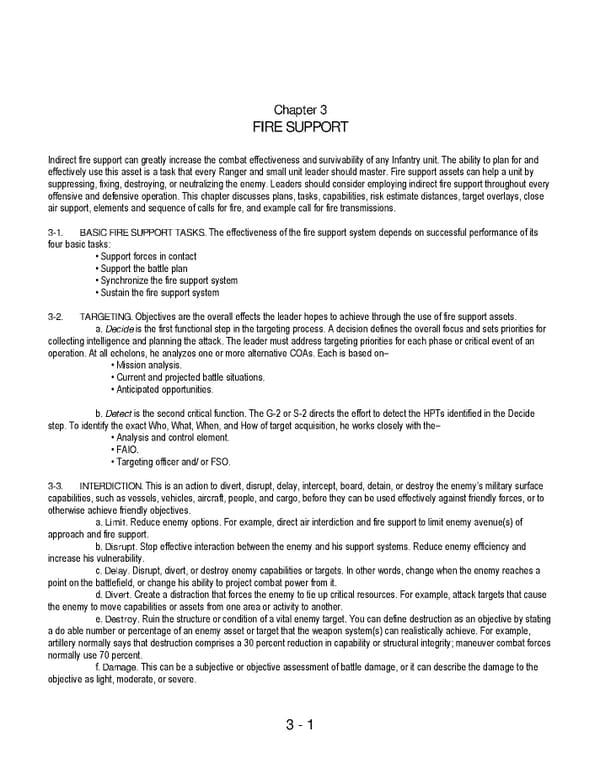3 - 1 Chapter 3 FIRE SUPPORT Indirect fire support can greatly increase the combat effectiveness and survivability of any Infantry unit. The ability to plan for and effectively use this asset is a task that every Ranger and small unit leader should master. Fire support assets can help a unit by suppressing, fixing, destroying, or neutralizing the enemy. Leaders should consider employing indirect fire support throughout every offensive and defensive operation. This chapter discusses plans, tasks, capabilities, risk estimate distances, target overlays, close air support, elements and sequence of calls for fire, and example call for fire transmissions. 3-1. BASIC FIRE SUPPORT TASKS. The effectiveness of the fire support system depends on successful performance of its four basic tasks: • Support forces in contact • Support the battle plan • Synchronize the fire support system • Sustain the fire support system 3-2. TARGETING. Objectives are the overall effects the leader hopes to achieve through the use of fire support assets. a. Decide is the first functional step in the targeting process. A decision defines the overall focus and sets priorities for collecting intelligence and planning the attack. The leader must address targeting priorities for each phase or critical event of an operation. At all echelons, he analyzes one or more alternative COAs. Each is based on– • Mission analysis. • Current and projected battle situations. • Anticipated opportunities. b. Detect is the second critical function. The G-2 or S-2 directs the effort to detect the HPTs identified in the Decide step. To identify the exact Who, What, When, and How of target acquisition, he works closely with the– • Analysis and control element. • FAIO. • Targeting officer and/ or FSO. 3-3. INTERDICTION. This is an action to divert, disrupt, delay, intercept, board, detain, or destroy the enemy’s military surface capabilities, such as vessels, vehicles, aircraft, people, and cargo, before they can be used effectively against friendly forces, or to otherwise achieve friendly objectives. a. Limit. Reduce enemy options. For example, direct air interdiction and fire support to limit enemy avenue(s) of approach and fire support. b. Disrupt. Stop effective interaction between the enemy and his support systems. Reduce enemy efficiency and increase his vulnerability. c. Delay. Disrupt, divert, or destroy enemy capabilities or targets. In other words, change when the enemy reaches a point on the battlefield, or change his ability to project combat power from it. d. Divert. Create a distraction that forces the enemy to tie up critical resources. For example, attack targets that cause the enemy to move capabilities or assets from one area or activity to another. e. Destroy. Ruin the structure or condition of a vital enemy target. You can define destruction as an objective by stating a do able number or percentage of an enemy asset or target that the weapon system(s) can realistically achieve. For example, artillery normally says that destruction comprises a 30 percent reduction in capability or structural integrity; maneuver combat forces normally use 70 percent. f. Damage. This can be a subjective or objective assessment of battle damage, or it can describe the damage to the objective as light, moderate, or severe.
 Ranger Handbook Page 54 Page 56
Ranger Handbook Page 54 Page 56